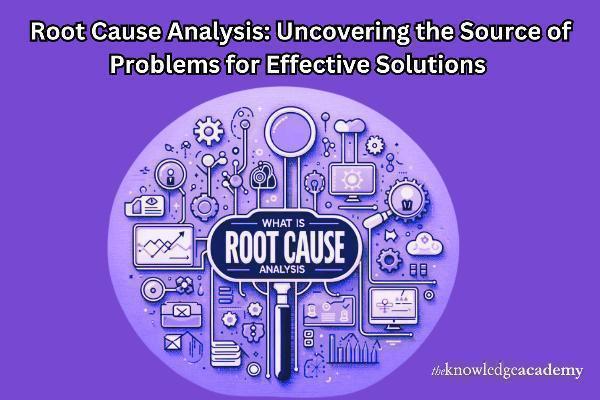Root Cause Analysis: Uncovering the Source of Problems for Effective Solutions

Strong8k brings an ultra-HD IPTV experience to your living room and your pocket.
Every organisation, whether a small startup or a large corporation, inevitably encounters issues or failures at some point. The challenge is not merely fixing these problems but understanding why they occurred in the first place. This is where Root Cause Analysis (RCA) becomes a vital tool. Instead of treating symptoms, RCA focuses on digging deep into the underlying causes, allowing businesses to prevent recurring problems and improve processes for the long term.
For those looking to master this essential problem-solving method, Root Cause Analysis Training can equip you with the knowledge and tools to identify the underlying causes of issues and implement effective solutions. In this blog, we'll explore what Root Cause Analysis is, why it’s essential, and how it can be applied across various sectors to drive continuous improvement.
Table of Content
- What is Root Cause Analysis?
- The Importance of Root Cause Analysis
- Common Techniques in Root Cause Analysis
- Steps to Perform an Effective Root Cause Analysis
- Benefits of Root Cause Analysis
- Conclusion
What is Root Cause Analysis?
Root Cause Analysis (RCA) is a systematic method used to identify the underlying causes of problems or failures. Rather than simply addressing the immediate effects of an issue, RCA helps teams trace the problem back to its origin. By identifying and addressing these root causes, organisations can develop solutions that prevent future occurrences.
RCA is widely used across industries, from manufacturing and engineering to healthcare and IT. In essence, RCA ensures that you're not just fixing what's on the surface but eliminating the root of the issue to stop it from happening again.
The Importance of Root Cause Analysis
Why is Root Cause Analysis so important? Because temporary fixes or band-aid solutions rarely provide long-term relief. Without understanding the root cause, businesses risk recurring problems, leading to wasted time, resources, and potential revenue loss. RCA provides several key benefits:
Prevention of Recurring Issues: Addressing the root cause ensures the problem doesn’t repeat, saving time and money.
Improved Processes: Identifying underlying issues often reveals flaws in processes, which can then be refined.
Higher Customer Satisfaction: By solving problems at their core, businesses can offer more reliable services or products, resulting in happier customers.
Increased Efficiency: When root causes are addressed, operations become smoother, leading to better resource allocation and productivity.
Common Techniques in Root Cause Analysis
There are several tried-and-tested techniques used in Root Cause Analysis, each helping organisations to uncover the primary sources of their problems. Some of the most popular methods include:
5 Whys: This technique involves asking “Why?” multiple times until the root cause is identified. It is particularly useful for simple to moderately complex problems and encourages deeper thinking.
Fishbone Diagram (Ishikawa Diagram): Also known as the cause-and-effect diagram, this tool visually maps out the potential causes of a problem. The “bones” represent different categories of causes, such as people, processes, materials, or equipment.
Pareto Analysis: This method is based on the Pareto principle (80/20 rule), which suggests that 80% of problems are typically caused by 20% of the causes. This helps teams focus on addressing the most impactful issues.
Failure Mode and Effects Analysis (FMEA): FMEA is a more structured approach, often used in manufacturing and engineering, to identify potential failures and their impact. This method helps teams prioritise which root causes to address first based on the severity of the failure.
Steps to Perform an Effective Root Cause Analysis
Performing Root Cause Analysis effectively requires a structured approach. Here are the key steps to ensure a thorough analysis:
Define the Problem: Start by clearly identifying the issue. The problem statement should be specific and measurable, ensuring everyone understands what needs to be resolved.
Collect Data: Gather all relevant data that can help in understanding the problem. This could include interviews, reports, logs, and observations related to the issue.
Identify Possible Causes: Brainstorm or use tools like the Fishbone Diagram to list all potential causes. This step helps explore every possible factor contributing to the problem.
Determine the Root Cause: Once all potential causes are identified, use methods such as the 5 Whys to drill down and discover the true root cause of the issue.
Develop and Implement Solutions: After identifying the root cause, develop solutions that directly address it. Ensure these solutions are sustainable and capable of preventing future occurrences.
Monitor and Verify: Once the solution is implemented, continue to monitor the situation to ensure the problem does not reoccur. If necessary, make adjustments to the solution.
Benefits of Root Cause Analysis
The advantages of using Root Cause Analysis in problem-solving are significant:
Better Decision-Making: RCA provides data-driven insights, allowing teams to make informed decisions rather than relying on guesses or assumptions.
Cost Efficiency: By addressing the root cause, companies can avoid recurring costs associated with rework, repairs, or customer dissatisfaction.
Continuous Improvement: RCA is an integral part of any continuous improvement process. It fosters a culture of accountability and ensures that systems and processes evolve over time.
Risk Management: Identifying root causes also helps in risk management, enabling businesses to be proactive in addressing potential future challenges before they arise.
Conclusion
Root Cause Analysis is a critical tool for any organisation seeking to improve its processes, reduce downtime, and prevent the recurrence of problems. By focusing on the underlying causes of issues, RCA not only solves immediate problems but also enhances overall business efficiency and performance.
For professionals looking to deepen their knowledge and application of RCA, consider Root Cause Analysis Training to equip yourself with the skills needed to conduct thorough and effective analyses. This training can help your organisation thrive by ensuring that problems are permanently solved at the root level.
Note: IndiBlogHub features both user-submitted and editorial content. We do not verify third-party contributions. Read our Disclaimer and Privacy Policyfor details.







